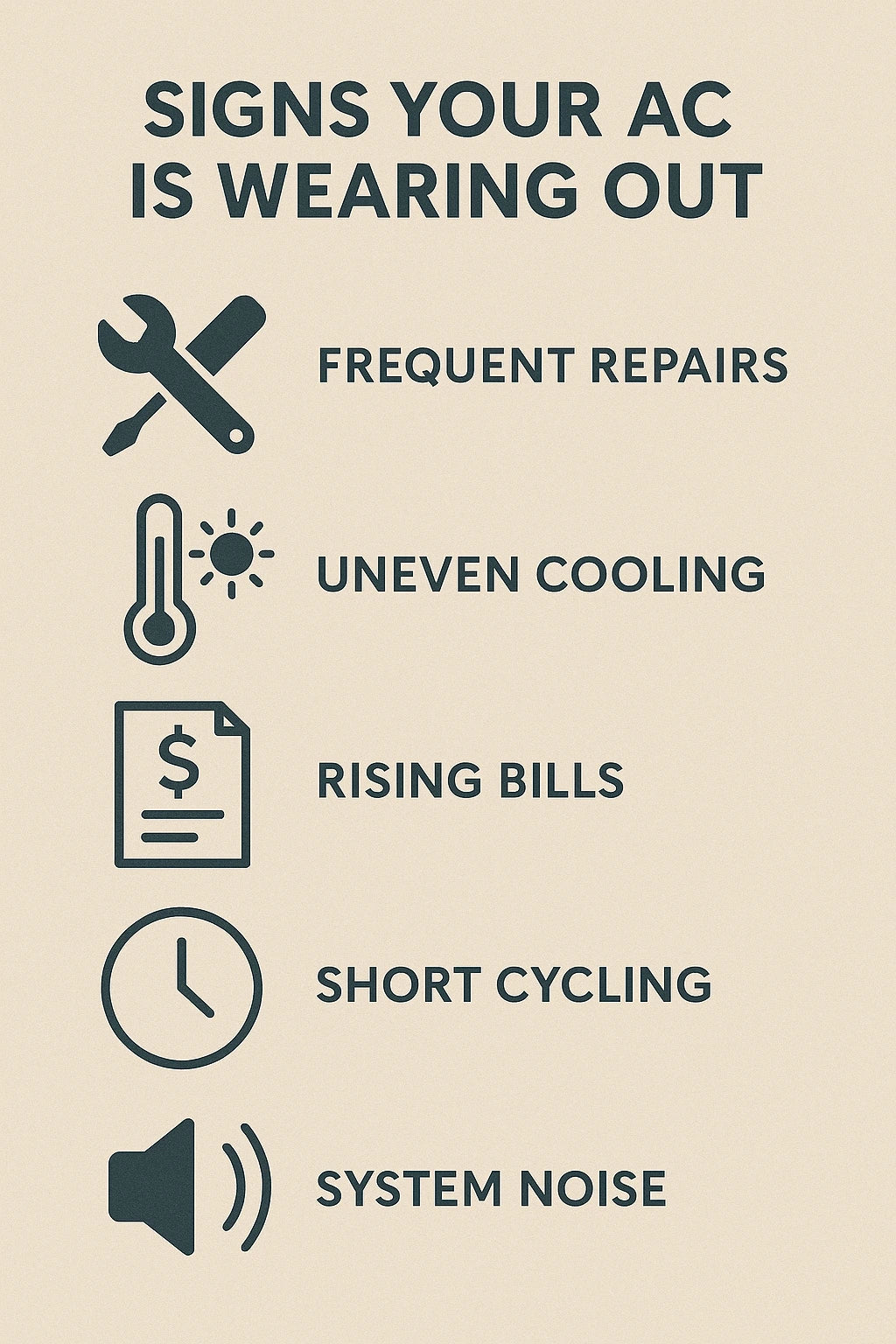If your AC is creeping past the 10-year mark, you’re probably wondering: how much longer will it last? Or maybe you’re buying a new system and want to know you’re getting long-term value.
Either way, understanding the typical lifespan of a central air conditioner—and the factors that affect it—can save you thousands in surprise breakdowns, rushed replacements, or energy bills that slowly climb year after year.
In this guide, we’ll cover average lifespans by brand, how usage patterns affect longevity, signs your system is aging, and simple steps you can take to extend its life.
🔗 Also read: Top 10 Central AC Units Compared
Average Central AC Lifespan by System Type
A well-maintained central AC unit typically lasts 15–20 years, though this range varies depending on brand, system type, climate, and how often it’s serviced.
Single-Stage vs. Variable-Speed Systems
-
Single-stage units (basic on/off operation): 12–15 years
-
Two-stage systems: 14–18 years
-
Variable-speed or inverter-driven models: 15–20+ years
Because variable-speed systems operate more efficiently and experience less wear during startup, they tend to last longer—especially when combined with annual maintenance.
📘 Energy.gov notes that proper care and seasonal checkups are essential to reaching your AC’s full lifespan.
Central AC Lifespan by Brand (2025 Data)
Brand reputation plays a big role in long-term reliability. Here’s how some of the top names stack up:
| Brand | Average Lifespan | Warranty Coverage | Durability Highlights |
|---|---|---|---|
| Trane | 18–22 years | 10-yr parts, 12-yr compressor | WeatherGuard top, spine-fin coil |
| Carrier | 15–20 years | 10-yr limited parts | ArmorCoat™ protection, high humidity models |
| Lennox | 15–20 years | 10-yr parts | Aluminum coils, SmartHinge™ panels |
| Rheem/Ruud | 14–18 years | 10-yr limited parts | Powder-coated cabinets, scroll compressors |
| Goodman | 12–16 years | Lifetime compressor (Amana only) | Budget-friendly but less robust design |
📘 Consumer Reports confirms that premium brands like Trane and Carrier tend to have longer life expectancy due to build quality and design innovation.
What Shortens (or Extends) AC Lifespan?
Even a top-of-the-line unit can fail early if it’s installed poorly or not maintained. Let’s break down what affects your AC’s longevity:
🔧 Maintenance Habits
Regular tune-ups are the most important factor. Skipping service allows dust buildup, clogged coils, low refrigerant, or worn parts to drag down efficiency and strain the system.
-
Annual maintenance is non-negotiable
-
Replace filters every 1–3 months
-
Clean debris from the outdoor unit
📘 Trane emphasizes that clogged filters, dirty coils, and neglected maintenance are leading causes of early AC failure—often shaving years off your system’s lifespan.
🌍 Climate Conditions
Where you live plays a big role:
-
Coastal areas: Salt in the air leads to corrosion (expect 2–5 years shorter lifespan)
-
Hot climates: More runtime = more wear
-
Cold climates: Less frequent use = longer average life
Consider ACs with coastal protection coatings or enclosed cabinets if you live near the ocean.
🛠️ Sizing & Installation Quality
An oversized unit will short cycle. An undersized one will overwork. Both lead to premature wear.
-
Make sure your unit was sized using a Manual J calculation
-
Poor ductwork, high static pressure, or improper refrigerant charge can also take years off your system
📘 ASHRAE research shows that improper installation is one of the leading causes of early HVAC failure in North America.
Signs Your AC Is Nearing the End
Not sure if your aging unit still has time left or if it’s on its last leg? Watch for these red flags:
⚠️ Higher Energy Bills
Your unit may run longer to hit the same temperature. Efficiency loss happens gradually, but the impact adds up.
⚠️ Frequent Repairs
Needing major components like capacitors, fan motors, or refrigerant top-offs multiple times in a season is a sign the system is aging out.
⚠️ Inconsistent Cooling or Short Cycling
If one room is warm and another is freezing—or the system constantly turns on/off—it could mean blower motor wear, dirty coils, or control board issues.
📘 Angi explains that if your AC is over 12 years old and you're staring down expensive repairs, it’s often smarter financially to replace it with a newer, more efficient model.
How to Maximize Your Central AC’s Lifespan
You don’t need to baby your AC—but a few smart habits can help it last closer to 20 years than 12:
✅ Filter Replacement Schedule
Use high-quality pleated filters and replace them every 30–90 days depending on pets, allergies, and usage.
✅ Annual Professional Tune-Up
Technicians should check refrigerant levels, test capacitors, clean the coil, and check airflow. Schedule it every spring.
✅ Smart Thermostat Use
Use features like adaptive recovery and temperature scheduling to reduce runtime and strain on your system.
✅ Outdoor Unit Protection
Clear away leaves, grass, and debris from the condenser. Keep at least 2 feet of clearance on all sides.
✅ Seal Your Ducts
Leaky ductwork forces your AC to work harder. Sealing and insulating ducts can cut energy loss by 20% or more.
Final Thoughts from Alex: Plan for the Next Chapter
Central AC systems don’t last forever—but they also shouldn’t surprise you with sudden failure.
Know your system’s age, watch for warning signs, and keep a maintenance record. That way, you can plan an upgrade on your own terms, not in a panic when your system dies on the hottest day of the year.
Want to see how today’s models compare in efficiency?
🔗 Next up: SEER2 Ratings of the Top Central AC Models in 2025
Alex Lane
Your Home Comfort Advocate







